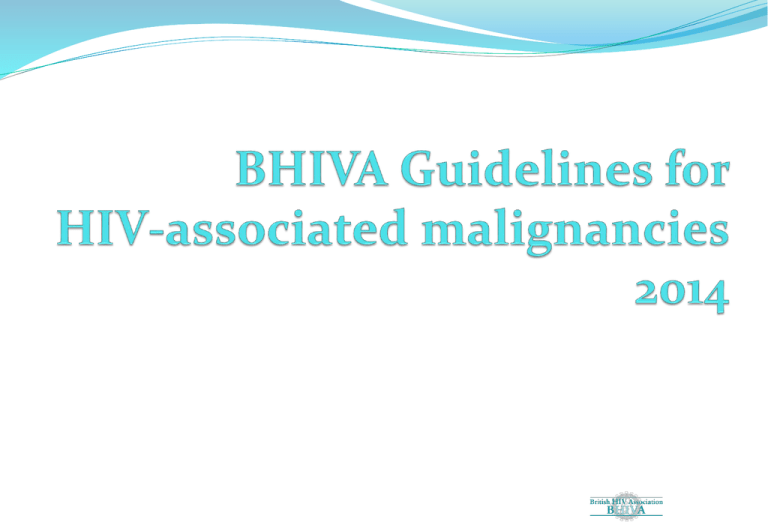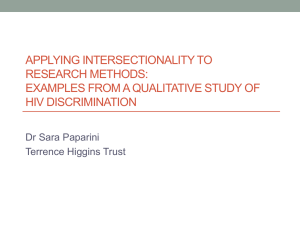
Scope and purpose
Provide guidance on best clinical practice
Treatment and management of adults with HIV infection and
malignancy
Do not address screening for malignancy in this population
Methodology
Modified GRADE system for review of
evidence (Appendix 1)
Multispecialty, multidisciplinary team – Oncology,
Haematology, HIV, CNS, Pharmacy
Patient involvement
Two patient representatives involved in all aspects of guideline
development
Additional two meetings with patients and community
representatives before writing group consensus meeting and as
part of public consultation process
Summary
HIV-associated Malignancies
Increased risk of:
AIDS-defining malignancies
Kaposi sarcoma
High grade B cell non-Hodgkin lymphoma
Invasive cervical cancer
Other malignancies
Anal cancer
Hodgkin lymphoma
Multicentric Castleman’s disease
Testicular germ cell cancer
Non-small cell lung cancer
Hepatocellular cancer
Other cancers
Summary
For optimal care, need shared expertise and collaboration
between
Oncology, Haematology, HIV, Palliative Care physicians
Clinical Nurse Specialists
Pharmacists
(see BHIVA Standards of Care for People Living with HIV 2013)
Large centres of care with expertise and >5000 PLHIV
Urgent referral of patients with suspected cancer, all to be seen
within 2 weeks in specialist unit
Test all for HIV
Start cART for all patients diagnosed with cancer
All require opportunistic infection (OI) prophylaxis
3. Kaposi sarcoma (KS)
Epidemiology
KS is caused by KSHV/HHV-8 virus.
Post-cART incidence of KS has decreased (0.3 vs 1.9/1000 person years,
hazard ratio 7), survival has increased
Management
Always confirm histologically (1C)
Test for HIV
CT, bronchoscopy, endoscopy only required if symptomatic (2D)
Start cART for all patients with KS (1B)
3. Kaposi sarcoma (KS)
Treatment
T0 (early stage KS): cART ± local radiotherapy (RT) or intralesional
vinblastine for cosmesis (2C)
T1 (advanced stage KS): cART and chemotherapy (1B)
First line: liposomal anthracyclines
Either liposomal daunorubicin (DaunoXomeTM) 40 mg/m2 q14d or liposomal
doxorubicin (CaelyxTM) 20 mg/m2 q21d (1A)
Second line: if refractory to anthracycline
Paclitaxel (TaxolTM) 100mg/m2 q14d (1C)
Consider clinical trial
4. Systemic AIDS-related
non-Hodgkin lymphoma (NHL)
Epidemiology
HIV increases risk of NHL
Second commonest tumour in PLWH
High-grade B cell NHL is an AIDS-defining illness
Presentation: advanced stage, B symptoms, extranodal disease including
bone marrow is common
cART reduces the risk of NHL
Survival of NHL in PLWH is the now the same as that seen in
HIV-negative people
Prognosis depends on histological subtype and stage
4. Systemic AIDS-related
non-Hodgkin lymphoma (NHL)
Management
Confirm histologically, requires expert review
HIV test
Clinical evaluation, bloods (Table 4.1), CT, bone marrow aspirate and
trephine, FDG-PET at diagnosis improves staging accuracy, CSF if CNS
symptoms or involvement of paranasal sinuses, breast, paraspinal
disease, testes, renal, epidural space, bone
4. NHL: systemic AIDS-related diffuse
large B-cell lymphoma (DLBL)
Treatment
Start cART, opportunistic infection prophylaxis and chemotherapy (1B)
First-line chemotherapy as for HIV-negative patients
CHOP or EPOCH
Add rituximab (1B) for CD20+ NHL
If CD4 <50 cells/ml, close monitoring advised, OI prophylaxis, G-CSF and prompt OI
treatment
If high risk of CNS relapse (high LDH, extranodal disease and high-risk sites
involved)
CNS prophylaxis (intrathecal (IT) and/or IV methotrexate) as for HIV-negative
patients (1C)
4. NHL: Burkitt lymphoma (BL)
High risk of CNS disease
Treatment
Start cART, opportunistic infection prophylaxis and
chemotherapy (1B)
First-line chemotherapy
CODOX-M/IVAC or DA-EPOCH (1B)
Add rituximab (1C)
Offer all BL patients prophylactic IT chemotherapy (1B)
4. NHL: relapsed/recurrent systemic
NHL
Relapsed/aggressive NHL
Second-line chemotherapy (1C) may contain platinum (2C)
If response (CR or PR), consider high-dose therapy (HDT) with
autologous stem cell transplantation (ASCT)
5. NHL: primary CNS lymphoma (PCNSL)
Epidemiology
Poor prognosis
cART reduces risk
Diagnosis
Presentation may be subacute/neuropsychiatric
Craniospinal involvement only, no systemic involvement
HIV test
Clinical assessment, bloods including LDH, CT/MRI brain, CSF (if safe) include EBV PCR on CSF,
CT CAP, USS testes
Confirm histologically: brain biopsy is the only confirmatory test
Treatment
Start cART (1C)
All patients with adequate performance status: consider treatment with regimen containing high-
dose methotrexate (1D)
Use whole-brain radiotherapy (RT) for palliation for symptom control or, as alternative
to first-line treatment if risk of toxicity from high-dose IV agents unacceptable (1C)
6. NHL: primary effusion lymphoma (PEL)
Epidemiology
3% of HIV-associated NHL
Poor prognosis
Lymphomas immunostain for HHV8 (+/-EBV)
Diagnosis
Requires expert histopathology review
Usually causes pleural or pericardial effusion or ascites without masses
Rare extracavity PEL presents with solid masses rather than effusions
Diagnosis from effusion: cellular morphology, immune phenotype, virology
HIV test
Treatment
Chemotherapy plus cART and opportunistic infection prophylaxis (1C)
CHOP-like regimens (2C)
Consider clinical trial
7. NHL: plasmablastic lymphoma
Epidemiology
2.6% of HIV-associated lymphomas
Three types: oral mucosal (EBV+ve); extra-oral (GIT, skin, nodal, splenic)
(EBV+ve); associated with multicentric Castleman’s disease (HHV8+ve)
Requires expert histopathology review
HIV test
Treatment
Chemotherapy plus cART and opportunistic infection
prophylaxis (1C)
Chemotherapy: anthracycline-containing regimen (1C)
8. Cervical intraepithelial neoplasia
(CIN) and cervical cancer
Epidemiology
Related to high-risk HPV (mostly 16 and 18)
Cervical cancer preceded by CIN
75% cases cervical cancer preventable by screening
Smoking increases risk
No change in risk of cervical cancer post cART
Driven by HPV
Increased risk of cervical cancer due to HIV much smaller than increase in HIVrelated KS/NHL
Survival bias masks effect as PLWH population lives longer
Modest decreased incidence of CIN post cART
Increased incidence of CIN with low CD4 cell counts
Screening
All HIV-infected women have annual cytology (and initial colposcopy if resources
permit) (2C)
Same age range as for HIV-negative women (1B)
8. Cervical intraepithelial neoplasia
(CIN) and cervical cancer
Management
HIV test
CIN 1
Less severe grades than CIN2: no treatment as it represents persistent HPV infection
not pre-malignancy (2B)
CIN 2/3
Manage as per UK guidelines
Excision: higher failure rate than in HIV-negative patients as high frequency of
compromised margins on excisional specimens; higher rates of treatment failure
Start cART: relapse less frequent with CD4 count >200cells/ml and undetectable HIV
viral load
Invasive cervical cancer
Manage as per UK guidelines for HIV-negative women within MDT framework (1B)
9. Anal cancer
Epidemiology
Relative risk 40–50 in HIV-positive MSM
Occurs at younger age in PLWH
Associated with high-risk HPV (mostly 16 and 18)
Incidence rising in post-cART era
May be due to longer survival with HIV allowing time for progression from
HPV to AIN to invasive anal cancer
Diagnosis
Role of annual cytology and anoscopy not proven: patients encouraged to
check and report lumps in anal canal (BHIVA BASHH FFPRHC 2008
guidelines on anal cancer in HIV)
Patients may present with rectal bleeding, anal pain, incontinence, but
may be asymptomatic
EUA anal canal and rectum, and biopsy all suspected cases (1D)
Further staging CT CAP, MRI pelvis (1B)
9. Anal cancer
Management
HIV test
Manage in specialist centres with experience (1C)
Centres managing anal cancer should be able to provide high resolution
anoscopy (HRA) (2D)
Treatment
Start cART (1C)
Start OI prophylaxis (1D)
Chemoradiotherapy (CRT) with 5-flourouracil and mitomycin C (1A)
Salvage surgery may be appropriate if loco-regional disease resistance or
relapse following CRT (2D)
Best supportive care may be more appropriate if metastatic disease or local
relapse following salvage surgery (2D)
Advocate surveillance for AIN by HRA (2D)
10. Hodgkin lymphoma
Epidemiology
Commoner in PLWH x10–20
Post-cART rates for CR/overall survival/disease-free survival same as
for HIV-negative patients
Increased incidence with CD4 <200 cells/ml, and CD4 count may
fall 1 year pre-HL diagnosis
EBV-driven
Diagnosis
Presentation in HIV infection: advanced stage, more symptoms, extranodal disease, poor
performance status
Histology EBV+ and mostly mixed cellularity (MC) or lymphocyte-depleted (LD), rather
than nodular sclerosis
Management
HIV test
Start cART and opportunistic infection prophylaxis (1A)
Avoid ritonavir: risk of vinblastine-mediated neuropathy and neutropenia (1D)
10. Hodgkin lymphoma
Management
First-line ABVD-based regimens
Early favourable: ABVD x2–4 + IFRT 20–30Gy (1B)
Early unfavourable: ABVD x4 + IFRT 30Gy (1B)
Advanced ABVD: x6–8 +/- RT (1B)
Relapse/refractory HL
Salvage chemotherapy
If chemosensitive, consolidate with HDT/ASCR (1B)
Assess response to treatment: FDG-PET scan and bone marrow biopsy (1D)
Assess during FU 2–4 monthly for 2 years then 3–6 monthly
for a further 3 years (1B)
If blood products required: give irradiated blood products
11. Multicentric Castleman’s disease
(MCD)
Epidemiology
HHV8-driven: present in all instances; rise in plasma HHV8 at relapse
cART does not prevent MCD: can present CD4 >200 cells/ml
Risk of NHL x15 higher than in PLWH without MCD
Diagnosis
Relapsing and remitting course
Biopsy lymph node histology: confirmatory stain for HHV8 and IgM lambda (2B)
Requires expert histopathology review
High HHV-8 blood level supports diagnosis (2C)
HIV test
Treatment
First line: rituximab (1B)
Start cART and opportunistic infection prophylaxis
Aggressive disease add chemotherapy (1C)
Relapse: re-treat with rituximab (1C)
Monitor
Measure HHV-8 level in blood (1C)
Rise can predict relapse (2D)
12. Testicular germ cell cancer
Epidemiology
Seminoma more frequent in HIV infection 3.7% RR
Younger age
Risk of over-staging due to HIV-associated lymphadenopathy
Management
HIV test
Chemotherapy plus cART and opportunistic infection
prophylaxis (2C)
Treatment the same as for HIV-negative population (2C)
Surveillance is safe for stage I disease (2C)
Bleomycin can be avoided in stage I disease as low-risk (2D)
12. Non-small cell lung cancer
Epidemiology
Increased risk in PLWH
Smoking, younger
Management
Biopsy, CT CAP including adrenals, bone scan, (interpret FDG-PET with
caution – low specificity), cranial imaging if symptoms
HIV test
Stop smoking (1B)
Offer potentially curative surgery when appropriate (2C)
Screen for activating endothelial growth factor (EGFR) mutations. If
present treat with tyrosine kinase inhibitors (TKIs) (2D)
No role for screening for lung cancer in PLWH
12. Hepatocellular carcinoma (HCC)
Epidemiology
Western world: 30% PLWH co-infected with hepatitis C (HCV) (75% IVDU)
High hepatitis B (HBV) viral load: increased risk HCC
Low CD4 cell count: increased risk hepatitis B-associated HCC
Management
HIV test
CT CAP to exclude metastases, liver USS, AFP, assess cirrhosis (fibroscan,
liver biopsy)
Treat HCC same as in HIV-negative people (2C)
Consider liver transplantation as appropriate as for HIV-negative people (2D)
Sorafenib is an option for advanced, inoperable HCC (2D)
Screen cirrhotic HBV and HCV co-infected patients with liver USS (1A)
and 6 monthly AFP (2C)
Consider screening non-cirrhotic HBV co-infected patients for HCC
12. Other cancers
Colorectal cancer
Increased risk of adenoma and adenocarcinoma in PLWH
Younger, more advanced disease, right-sided cancers
Chemotherapy and cART and opportunistic infection prophylaxis
Skin cancer
Increased risk x5 SCC, BCC and x2–3 melanoma
Atypical presentation
HPV-driven cancers
cART and opportunistic infection prophylaxis and treatment
Merkel cell carcinoma (MCC)
12. Other cancers
Cutaneous lymphoma
Mycosis fungoides, Sézary syndrome
Penis precancer (PIN) and cancer
PIN: increased risk in uncircumcised men
Penile cancer x5–6 increased risk
Other cancers
AML more aggressive, increased deaths OIs
Head, neck and breast cancer – more aggressive
Prostate cancer
Management
HIV test, cART and opportunistic infection prophylaxis
Standard care, large centre with MDT expertise
13. Opportunistic infection (OI)
prophylaxis
All PLWH requiring cancer treatment should be on cART (1B)
Pneumocystis jirovecii pneumonia (PCP)
CD4 <200 cells/ml (1A), consider at higher levels when giving chemo/RT (also
protects against cerebral Toxoplasma gondii).
Co-trimoxazole
Mycobacterium avium complex (MAC)
CD4 <50 cells/ml (1B) or if risk of CD4 falling below this level. Azithromycin
Fungal infections
Systemic azole for all chemo/RT (1D)
Bacterial infections
Co-trimoxazole for PCP prophylaxis may provide some protection against bacterial
infections (1C)
Routine fluoroquinolone prophylaxis not recommended in low-risk patients
13. Opportunistic infection (OI)
prophylaxis
Herpes simplex virus (HSV)
Prophylaxis (aciclovir) recommended during chemotherapy (1D)
Influenza virus
Annual vaccination (1B)
Pneumococcus
Vaccination (1D)
Hepatitis B virus (HBV)
Vaccination (1D)
Hepatitis B virus core antibody positive
Treat with prophylactic antivirals in line with BHIVA hepatitis
guidelines (1B). (If on cART, Truvada-containing regimen will provide
this)







